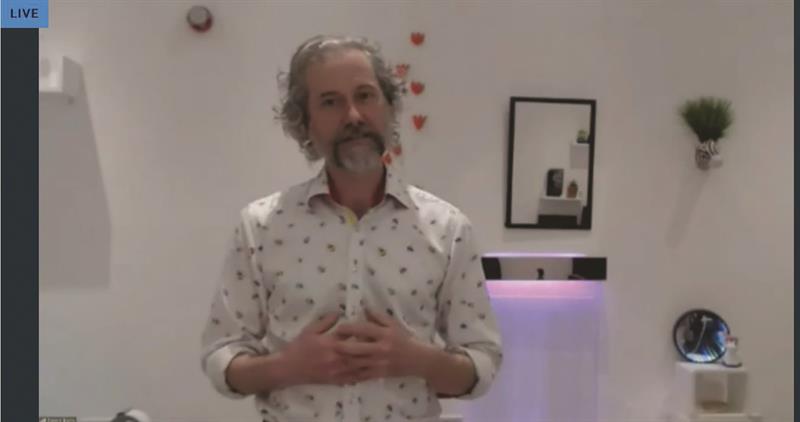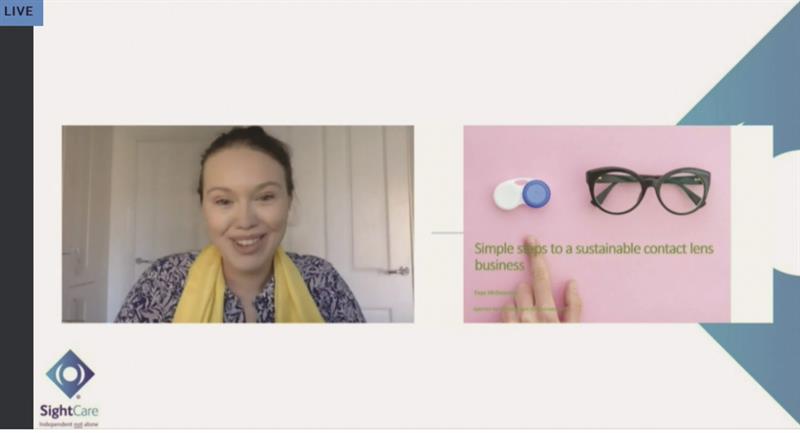
Over 600 delegates to SightCare’s first virtual conference logged into the specially designed web portal to attend the independent group’s business and networking event on February 28.
SightCare’s chief executive, John French, welcomed attendees and laid out the itinerary of interactive sessions and webinars for the two-day event. ‘While an online event can never replace a face-to-face conference,’ he said, ‘I do hope that this conference can help to get you together with colleagues.’
French’s hopes were realised throughout the conference as delegates made use of a suite of interactive features built into the virtual platform to ask questions, interact with each other and make comments. SightCare’s conference sessions received over 6,000 clicks on their watch buttons, showing the popularity of the event.
French’s welcome finished with a piece of advice to independent practitioners: ‘We have seen the switch to online shopping growing exponentially and when we come out of the pandemic we may see a growth in demand for face to face interactions. As an independent optical supplier, you can no longer afford to cater to everyone, and many independents have found success with an appointment-only business model.’
Reasonable adjustments
An important session on caring for patients with learning disabilities was hosted by Simon Berry, a practice owner who also works as a specialist optometrist at Sunderland Eye Infirmary. Berry’s session focused not on providing specific advice for caring for this group of patients, but on providing a framework for how practitioners should think about the process of caring for them.
 Simon Berry
Simon Berry
He began by highlighting the healthcare inequalities, including optical pathology, that this group experiences: ‘Those with learning disabilities have reduced life expectancy, are more likely to have both types of diabetes and epilepsy, which I mention as this can cause visual issues. Ten percent of people with learning disabilities have some sort of condition that affects their vision and studies show they have a greater range of refractive error.’
Berry added that optic pathways disorders were more common in this group alongside nystagmus, eye tracking abnormalities, visual field defects and cerebral visual impairment. He highlighted some of the procedures and frameworks he had implemented to better cater to patients with learning disabilities, who may not respond to standard procedures as expected.
‘In all parts of the patient journey we need to be thinking about the reasonable adjustments we can make to ensure we’re doing the best we can to engage patients with learning disabilities,’ he explained, ‘Before the eye test we need to identify the patient, and can make appointments for when the waiting room may be quiet or for when scheduling allows for time to overrun slightly.’ Acclimatisation visits were also highlighted by Berry as important to how he operates his practice, as they allow patients to become familiar and comfortable with their surroundings and ask questions if they want to.
Wow Factor
Katie Memory, owner of Memory Opticians, gave a talk where she emphasised the value of customer service and a personalised, unique patient journey. She explained that customer service is not simply a requirement to be fulfilled but an opportunity to become more competitive and improve revenue. ‘Delivering great service makes sense for your bottom line,’ she said. ‘Eight-four percent of customers say customer service is essential to their choice and a customer who is totally satisfied is six times more likely to stay loyal.’
Memory added that the Covid-19 pandemic has intensified patient’s desire for excellent service: ‘Covid has brought forth a customer that is so much more thoughtful and part of this is customers looking for businesses that build trust. Factors like your brand purpose and reputation are all coming into the decision process in equal measure.’
Independents were the ones set to benefit from this renewed desire for personalised service, explained Memory. She also recommended independents ask for patient feedback and measure it effectively to keep tabs on customer service performance, so that it could be constantly approved and adapted.
Highlighting the vital importance of patients’ experiences when in practice, Memory said: ‘People will forget what you said, what you did, but will never forget how you made them feel.’
Clinically liberating experiences
On the second day of the conference, David Samuel, a SightCare Premium business coach, led a discussion with a panel of six optometrists who explored the reasons for ending general ophthalmic services and what to consider when making the switch. Each practitioner shared their experience of going private and how it worked for them.
Eva Davé transformed her practice into a high end boutique eyewear styling business called Style Optique and explained that she set out to create a luxury practice that patients would be willing to travel to.
Davé was the only practitioner on the panel who had not yet gone fully private and still operated a hybrid model. She added that although it was not a priority, the practice could make the switch in the future.
‘I’d say 40% of our clients are private anyway and they pay £75 for the sight test and the scan. Of the 60% that are NHS, 87% have a scan and pay for that upgrade anyway,’ she explained.
Brian Tompkins, who operates Tompkins Knight & Son in Northampton, said he differentiates the practice’s offering through technology and contact lenses. The practice went fully private during the first lockdown and care package subscriptions are now offered across all services.
He said: ‘Myself and the three other directors decided [to go private] when the first lockdown happened. We were very blessed by quite a large direct debit coming in on a monthly basis to help us survive and we thought, “Right, well let’s take the plunge and go totally private.” We took an even bigger step. I got pushed by the others to go completely care plan. So, we’re now totally private and totally care plan.’
Alisdair Buchanan from Buchanan Optometrists said, when he took over a practice in Snodland, he wanted to offer the best service possible because he felt he had nothing to lose. Initially, he charged for top of the range coated lenses but the eye exam was still cheap.
‘I realised we had to change what we were doing because the business model of an optometrists is really flawed. The fact that we’re undercharging for eye examinations is absolutely ridiculous. I then took the jump and thought, “Let’s really start charging properly for eye examinations.” Now we charge between £275 and £450 for an eye examination,’ he explained.
Sophie Taylor-West worked in a private only practice before opening Taylor-West & Co Optometrists in Hove. She considered NHS services when opening, but decided there were too many hoops to jump through and it was not going to pay for overheads. ‘I’d rather just offer the best service and trust that people have come to see me because they’re after the best,’ Taylor-West said.
David Bennett, from Brooks and Wardman Optometrists, went fully private in July, 2020. He explained he spent a lot of time thinking about his business model, why he was part of the NHS and why it does not work in optometry. He came to the conclusion that his business wouldn’t survive if it continued to follow that model.
‘The only time it does work, is if you use it like a sausage factory and you push people in one end and push them out the other, flog them a pair of glasses and you do 30 or 40 tests a day. That works but that’s not the model I wanted to be,’ he explained.
Keval Sejpar, who operates McAusland Optometrists in Exmouth, Devon, said before going private his patient base understood the value of services and they bought into the hybrid model. He would charge a top up fee for fundus and OCT but wanted to offer the best.
Previously, he said, he had never been brave enough to go private and often asked himself, ‘what if the 6% of patients who are GOS leave and we lose the rest of their spend?’ Again, it was Covid-19 that influenced the decision to switch.
‘It was the hardest and scariest thing we’ve ever done in the practice but by far and away the best thing we’ve ever done. It’s been clinically liberating because all of a sudden I feel like I’m looking after people properly, the way that I want to,’ he said.
When switching to private only, communication was highlighted as the most important factor to get right in order to make it work. Bennett said: ‘What you’re doing as a practitioner is putting yourself and your thought process forwards as an entity and not including anything outside of it.’ He added that practitioners should not talk about the NHS not being fit for purpose as it turns patients off.
Taylor-West added that if patients give you the time to explain why the practice is private only then they could end up being patients at the practice forever. ‘Once you’ve got them in, I don’t think we lose a lot of people because once we show them what they’re paying for, they come back and they recommend us,’ she said.
Top tips for a sustainable contact lens business
Specialist optometrist and contact lens expert Faye McDearmid provided advice on how to create a successful contact lens business in your practice
 Faye McDearmid during her talk
Faye McDearmid during her talk
- Think about where you want to sit in the market and which customers you want to sell to. Do you want to focus on convenience, care or value?
- Emphasise elements of the customer experience that save time and effort. Can you schedule automatic lens arrivals specifically for their needs? Can you implement home delivery or click-and-collect?
- Reassure patients that you can provide optimum health, care and products alongside the procedures they are after.
- Can you implement preferential pricing for contact lens subscribers? Maybe this could include complimentary trials of new lenses and defined benefits.
- Move contact lens patients to a subscription-based care plan that covers the cost of your clinical time. Then, separate your professional fee from the product fee to show your worth and more effectively compete on prices.
- Implement a care plan to create a regular direct debit income from patients and increases patient loyalty.
- Consider the true cost of your time when thinking about your plan’s fee. Look at your businesses’ running costs minus product costs and settle on a reasonable price point.
- Consider how you and your team talk about contact lenses to patients. Always include a spectacle-free option when talking about vision correction in your practice.
- Make sure your team understand the benefits of your care plan and can communicate this simply and effectively to patients.
